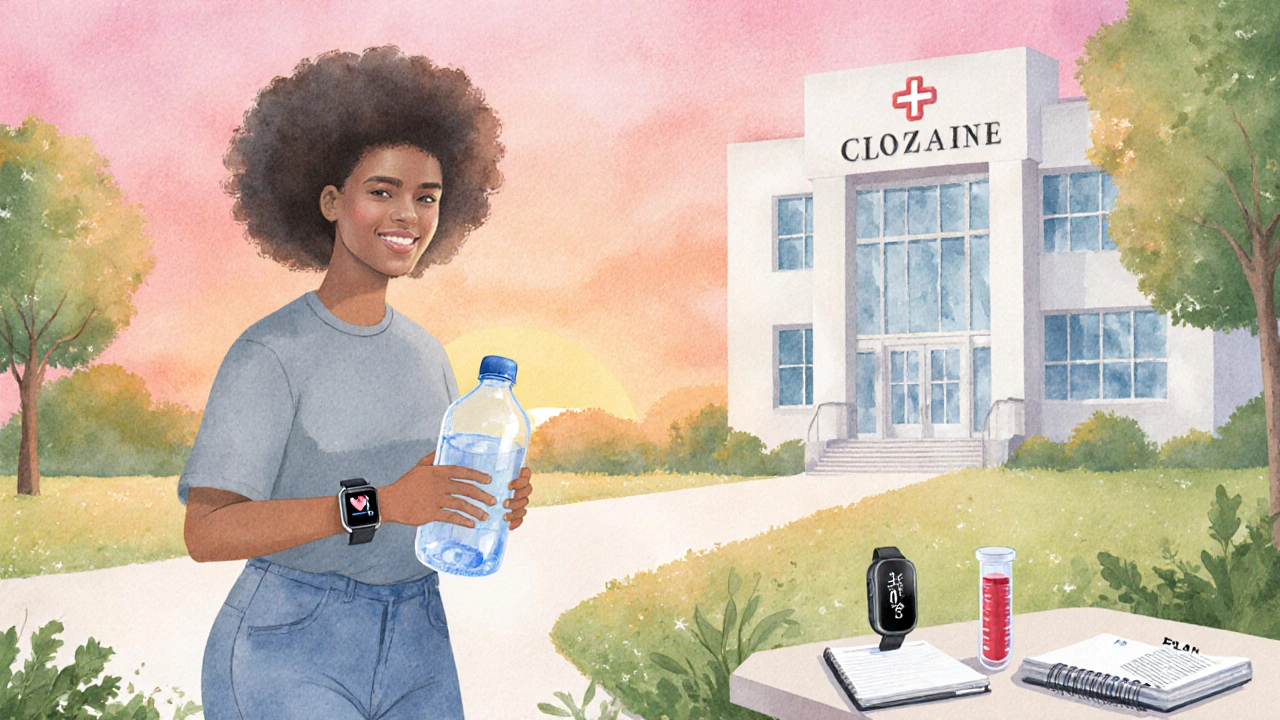 Oct, 8 2025
Oct, 8 2025
Antipsychotic Comparison Tool
Comparison Results
Clozapine is a second‑generation antipsychotic approved for treatment‑resistant schizophrenia and reducing suicidal risk in patients with schizoaffective disorder. Unlike most oral antipsychotics, it requires regular blood monitoring because of the risk of agranulocytosis, a potentially life‑threatening drop in white‑blood cells.
Quick Takeaways
- Clozapine offers the highest efficacy for patients who haven’t responded to at least two other antipsychotics.
- It carries unique safety demands: weekly CBCs for the first 6months, then every 2weeks.
- Common alternatives - olanzapine, risperidone, quetiapine, aripiprazole, haloperidol - vary in metabolic side‑effects, sedation, and dosing convenience.
- Metabolic syndrome is a major concern with many atypicals; clozapine is the worst offender for weight gain and glucose dysregulation.
- Cost and insurance coverage differ dramatically; clozapine often needs special pharmacy handling.
Understanding Clozapine
When a patient fails two adequate trials of antipsychotics, guidelines push clinicians toward clozapine. Its pharmacology blocks dopamine D2 receptors while also hitting a broad range of serotonin, norepinephrine, and muscarinic receptors. This “wide‑net” action reduces positive symptoms (hallucinations, delusions) and can improve negative symptoms (flattened affect, social withdrawal).
Because of the agranulocytosis risk, the drug is dispensed through a certified registry. Patients must sign a consent form, and clinics track absolute neutrophil counts (ANC). If ANC falls below 1,500 cells/µL, the medication is stopped immediately.
Major Alternatives Overview
Below are the most frequently prescribed antipsychotics that clinicians consider before clozapine.
- Olanzapine - potent D2 and 5‑HT2A blockade, strong sedation, high metabolic side‑effects.
- Risperidone - well‑balanced efficacy, dose‑dependent prolactin elevation, moderate weight gain.
- Quetiapine - low D2 affinity, useful for insomnia, modest efficacy for psychosis, prominent sedation.
- Aripiprazole - partial D2 agonist, lower metabolic risk, may cause akathisia.
- Haloperidol - first‑generation, strong D2 blockade, high EPS risk, minimal metabolic impact.
All these agents treat schizophrenia but differ in side‑effect profiles, dosing convenience, and monitoring requirements.
Side‑Effect Landscape
Metabolic syndrome - a cluster of weight gain, hyperglycemia, and dyslipidemia - is the most common reason clinicians switch drugs. Clozapine leads this pack, followed by olanzapine. Risperidone and quetiapine sit in the middle, while aripiprazole and haloperidol have the lowest metabolic impact.
Extrapyramidal symptoms (EPS) such as tremor and rigidity are rare with clozapine but common with haloperidol and higher‑potency typicals. Sedation, orthostatic hypotension, and anticholinergic effects also vary: quetiapine and olanzapine are the most sedating.
Comparison Table
| Attribute | Clozapine | Olanzapine | Risperidone | Quetiapine | Aripiprazole | Haloperidol |
|---|---|---|---|---|---|---|
| Typical Use‑Case | Treatment‑resistant schizophrenia | First‑line, especially with mood features | Acute psychosis, switcher | Sleep‑disturbance, adjunct | Patients sensitive to metabolic gain | Severe agitation, inpatient |
| Response Rate (≥50% reduction) | ≈70% | ≈55% | ≈50% | ≈45% | ≈48% | ≈40% |
| Weight Gain (kg/yr) | 4-6 | 3-5 | 2-3 | 1-2 | 0.5-1 | 0-0.5 |
| Risk of Agranulocytosis | 0.8% (requires CBC) | Negligible | Negligible | Negligible | Negligible | Negligible |
| EPS (Parkinsonism/akathisia) | Rare | Low‑moderate | Moderate (dose‑dependent) | Low | Low‑moderate (akathisia) | High |
| Monitoring Frequency | Weekly CBC ×6mo, then bi‑weekly | Baseline labs, then PRN | Baseline labs, then PRN | Baseline labs, then PRN | Baseline labs, then PRN | Baseline ECG if high dose |
| Average Monthly Cost (USD) | $150-$250 (registry premium) | $80-$120 | $70-$110 | $60-$100 | $85-$130 | $50-$90 |
When to Choose Clozapine
Consider clozapine if:
- The patient has failed two adequate trials (≥6weeks each) of different antipsychotics.
- There is a high risk of suicide or persistent aggression.
- The healthcare setting can support regular blood draws and registry enrollment.
Even with these criteria, discuss the trade‑offs openly. Some patients prioritize avoiding weight gain, while others fear blood draws.

Practical Tips for Clinicians and Patients
- Set up a standing order for weekly CBCs before the first prescription is filled.
- Educate patients about early signs of infection - fever, sore throat, mouth ulcers.
- Start at 12.5mg once daily; titrate slowly to 300-450mg/day based on response and tolerability.
- Monitor fasting glucose, lipid panel, and weight every 3months.
- Consider adding metformin early if weight gain exceeds 5% of baseline.
Risk Mitigation Strategies
To lower agranulocytosis impact:
- Enroll in the national clozapine monitoring program (e.g., REMS in the US, local registry in Australia).
- Use point‑of‑care CBC devices in clinic to reduce patient travel.
- Have an emergency plan: if ANC < 1000, hold drug and start broad‑spectrum antibiotics if infection suspected.
For metabolic concerns, pair clozapine with lifestyle counseling, regular exercise, and low‑glycemic diet. Some clinicians add a GLP‑1 agonist when weight gain becomes problematic.
Frequently Asked Questions
Why is clozapine considered a “last‑resort” drug?
Because it’s the only antipsychotic with proven efficacy in patients who haven’t improved after at least two other medications, but it also carries serious safety risks that require intensive monitoring.
Can I take clozapine with other antipsychotics?
Combination therapy is possible in very specific scenarios (e.g., augmenting with a partial agonist for residual negative symptoms), but it increases side‑effect burden and should be managed by a specialist.
How often do I need blood tests while on clozapine?
Weekly absolute neutrophil counts for the first six months, then every two weeks thereafter as long as counts stay above the safety threshold.
Is clozapine more likely to cause diabetes than other antipsychotics?
Yes. Studies show a 2‑3‑fold increase in new‑onset diabetes compared with agents like aripiprazole, largely due to weight gain and direct effects on insulin sensitivity.
What should I do if I develop a fever while taking clozapine?
Contact your prescriber immediately. Fever can be an early sign of agranulocytosis. Your doctor will likely order an urgent CBC and may temporarily stop the medication.

Andy McCullough
October 8, 2025 AT 13:11When you dig into the pharmacodynamics of clozapine, you’ll notice its broad-spectrum antagonism at D2, 5‑HT2A, α‑adrenergic, and muscarinic receptors, which accounts for its superior efficacy in refractory psychosis. The drug’s high affinity for the serotonin-dopamine interface helps alleviate both positive and negative symptoms, but that same promiscuity fuels a cascade of metabolic derangements. Agranulocytosis risk, while statistically low, mandates a stringent CBC schedule that can strain outpatient workflows. Compared to olanzapine’s weight gain of roughly 3–5 kg per year, clozapine pushes the envelope toward 4–6 kg, compounding diabetes risk. Yet the response rate hovering around 70% makes it the only evidence‑based option after two failed trials. Clinicians must balance the hematologic surveillance burden against the potential to avert rehospitalization. In practice, setting up a standing order for weekly labs before the first prescription can smooth the logistics. Moreover, early metabolic monitoring-fasting glucose and lipid panel every three months-helps catch trends before they become entrenched. The cost differential, often $150–$250 per month, reflects the registry premium and should be factored into insurance negotiations. Ultimately, clozapine’s risk‑benefit profile is unique and demands a multidisciplinary approach.
Zackery Brinkley
October 8, 2025 AT 14:35It’s tough but the support system makes a huge difference.
Luke Dillon
October 8, 2025 AT 15:58Looking at the table, you can see that clozapine really shines when other meds have failed, but the trade‑offs are real. Patients love the symptom relief, yet the regular blood draws can feel like a constant reminder of the drug’s seriousness. If you’re comfortable with the monitoring rigors, the jump in response rate is worth it for many. On the other hand, if metabolic side‑effects are a deal‑breaker, alternatives like aripiprazole or even haloperidol (if you can tolerate EPS) might be more palatable. It all boils down to personal priorities and the clinic’s capacity to handle the lab schedule.
Elle Batchelor Peapell
October 8, 2025 AT 17:21That balance feels a lot like walking a tightrope in a storm; you’ve got to keep your eyes on the horizon while your feet stay glued to the rope. Clozapine offers that rare view from the top, but the wind of blood tests can knock you off if you’re not strapped in. It’s an existential trade‑off: freedom from psychosis versus the cage of constant monitoring.
Jeremy Wessel
October 8, 2025 AT 18:45Clozapine works; blood draws are mandatory.
Laura Barney
October 8, 2025 AT 20:08Imagine stepping into a kaleidoscope of colors where each hue represents a different side‑effect-there’s the deep red of agranulocytosis, the neon orange of weight gain, the electric blue of sedation. Clozapine dazzles with its powerful anti‑psychotic palette, but it also splashes a few harsh shades that can overwhelm the canvas of daily life. The good news: you can temper the intensity with lifestyle brushes-low‑glycemic meals, regular cardio, and a tight collaboration with your healthcare team. Think of the monitoring schedule as a rhythmic drumbeat that keeps you in sync with the medication’s tempo. When the beat is steady, the symphony of symptom relief can truly shine.
Jessica H.
October 8, 2025 AT 21:31While the metaphorical canvas is vivid, the clinical reality demands precise adherence to protocol. The agranulocytosis threat, albeit low in incidence, mandates a non‑negotiable hematologic surveillance schedule that, if disregarded, can lead to catastrophic outcomes. Moreover, the financial implications of the registry surcharge should be critically evaluated against insurance formularies before initiating therapy.
Tom Saa
October 8, 2025 AT 22:55From a purely data‑driven perspective, clozapine’s efficacy outpaces all other antipsychotics listed, with a response rate of approximately 70% versus 40‑55% for the alternatives. Its side‑effect profile, however, includes the highest metabolic burden and a mandatory weekly CBC for the first six months, which differentiates it substantially from the other agents.
John Magnus
October 9, 2025 AT 00:18When clinicians confront treatment‑resistant schizophrenia, the algorithmic pressure to pivot to clozapine is non‑negotiable. The drug’s dopamine D2 antagonism, coupled with a pan‑receptor profile, translates into a response rate that eclipses first‑generation agents. However, the safety rubric is unforgiving, demanding weekly absolute neutrophil counts for half a year before any relaxation is permitted. Agranulocytosis, albeit statistically rare at 0.8%, carries a mortality risk that dwarfs the modest metabolic penalties of olanzapine. From a pharmacoeconomic standpoint, the registry surcharge inflates the monthly outlay to roughly $200, a figure that insurance matrices often balk at. Nonetheless, the cost‑benefit calculus flips when the patient exhibits persistent suicidality or refractory aggression. In such high‑risk phenotypes, the incremental financial burden is justified by the reduction in hospitalization days. Metabolic monitoring should be proactive; initiating metformin at a five‑percent weight gain threshold can blunt the glucose surge. Equally important is patient education-early fever or sore throat must trigger an immediate CBC before the next dose. The clinical workflow can be optimized by integrating point‑of‑care hematology devices, slashing patient travel time and improving adherence. If a clinician hesitates because of EPS concerns, remember that clozapine’s extrapyramidal profile is virtually negligible compared with haloperidol. Conversely, the sedative load of quetiapine often necessitates dose titration to avoid daytime somnolence. Therapeutic drug monitoring is optional but can elucidate subtherapeutic plasma levels that masquerade as treatment failure. When clozapine is combined with a partial D2 agonist, the synergistic effect may address residual negative symptoms without amplifying metabolic risk. Ultimately, the decision matrix hinges on the institution’s capacity to sustain rigorous blood surveillance and the patient’s willingness to engage in that regimen. Skipping clozapine in a bona‑fide resistant case is tantamount to clinical inertia and compromises the standard of care.
Marc Clarke
October 9, 2025 AT 01:41That’s a solid breakdown-keep the optimism flowing, and remember that every extra lab can be a safety net rather than a hassle.
angelica maria villadiego españa
October 9, 2025 AT 03:05I’m glad we have this comparison tool; it makes navigating the maze of antipsychotics a lot clearer for patients and providers alike.